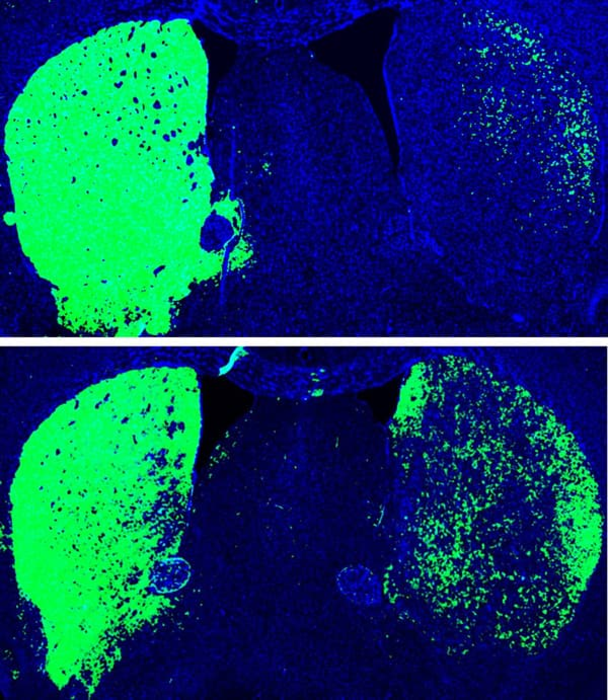Researchers around the world have tried many ways, and for many years, to generate neurons in the lab so they could study them better. Neurons-on-demand might also provide a therapeutic option for replacing neurons lost in neurodegenerative conditions, such as Parkinson’s disease. In June 2020, University of California San Diego School of Medicine researchers announced a major step toward that goal: With one dose of a new proto-drug, they were able to turn other cell types directly into neurons, a feat that alleviated all Parkinson’s disease symptoms in a mouse model.

Credit: UC San Diego Health Sciences
Researchers around the world have tried many ways, and for many years, to generate neurons in the lab so they could study them better. Neurons-on-demand might also provide a therapeutic option for replacing neurons lost in neurodegenerative conditions, such as Parkinson’s disease. In June 2020, University of California San Diego School of Medicine researchers announced a major step toward that goal: With one dose of a new proto-drug, they were able to turn other cell types directly into neurons, a feat that alleviated all Parkinson’s disease symptoms in a mouse model.
Now, the UC San Diego-led team will receive a $9 million grant from the Aligning Science Across Parkinson’s (ASAP) initiative to help advance this research and position it for the next phases of drug development. ASAP is a coordinated research initiative to advance targeted basic research for Parkinson’s disease. Its mission is to accelerate the pace of discovery and inform the path to a cure through collaboration, research-enabling resources and data-sharing. The Michael J. Fox Foundation for Parkinson’s Research is the implementation partner for ASAP and issuer of the grant, which contributes to the Campaign for UC San Diego.
Xiang-Dong Fu, PhD, Distinguished Professor of Cellular and Molecular Medicine is the lead investigator for the project, along with William C. Mobley, MD, PhD, Distinguished Professor of Neurosciences; and Bing Ren, PhD, and Steve Dowdy, PhD, both professors of cellular and molecular medicine at UC San Diego School of Medicine. The team also includes researchers from the Chinese Academy of Sciences.
“This grant is supporting some of the most incredible progress being made in the Parkinson’s sphere. It’s a game-changing strategy that we hope will improve how Parkinson’s is treated,” said David Brenner, MD, vice chancellor of Health Sciences. “We are grateful to ASAP for making these advancements possible.”
The team’s work centers on a protein called PTB, which is known for binding RNA and influencing which genes are turned “on” or “off” in a cell. Their previous studies showed that inhibiting the gene that encodes PTB transforms several types of mouse cells directly into new neurons in laboratory dishes.
To inhibit PTB in living organisms, the researchers developed a virus that carries an antisense oligonucleotide sequence — an artificial piece of DNA designed to specifically bind the RNA coding for PTB, thus preventing it from being translated into a functional protein and instead stimulating neuron development. The virus infects brain cells, but cannot be transmitted from the injected mice to others.
The researchers have demonstrated that just a single treatment to inhibit PTB in mice converts native astrocytes, star-shaped support cells of the brain, into neurons that produce the neurotransmitter dopamine. Treatment restores normal dopamine levels in mice engineered to mimic Parkinson’s disease. Physically, the mice recover motor function within three months after a single treatment, and remain free from Parkinson’s disease symptoms for the rest of their lives.
Of course, mice aren’t people, and the animal model the team used doesn’t perfectly recapitulate all essential features of Parkinson’s disease. But the study provides an exciting proof of concept, they said.
With ASAP’s support, the researchers will now be able to optimize their methods and test the methodology in other pre-clinical models. They have also patented the PTB antisense oligonucleotide treatment in order to move forward toward testing in clinical trials.
Parkinson’s disease is a brain disorder that progressively worsens, leading to shaking, difficulty with coordination and struggles with walking and talking. The condition occurs when neurons in an area of the brain that controls movement slowly cease to function properly and die. Normally, these neurons produce a brain chemical called dopamine. When neurons become impaired, they produce less dopamine, which causes the movement problems indicative of the disease.
Although there is no current cure for Parkinson’s disease, there are some medicines and surgical treatments that can relieve some symptoms, such as medications that increase dopamine levels or therapeutically affect other brain chemicals.
Private support, like the grant from ASAP, contributes to the Campaign for UC San Diego — a university-wide comprehensive fundraising effort concluding in 2022. Alongside UC San Diego’s philanthropic partners, the university is continuing its nontraditional path toward revolutionary ideas, unexpected answers, lifesaving discoveries and planet-changing impact. Learn more at Campaign for UC San Diego.
# # #




